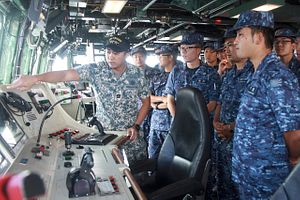Over the past few weeks, Singapore and Japan have been engaged in a series of interactions in the naval realm. The activities have once again put the spotlight on the maritime aspect of the defense relationship between the two countries as well as the naval interactions involving members of the U.S.-led alliance and partnership network in the broader Indo-Pacific amid wider domestic and regional developments that are underway.
Singapore and Japan already have longstanding security ties, which includes ties between the Republic of Singapore Navy (RSN) and the Japan Maritime Self-Defense Forces (JMSDF). Apart from bilateral interactions such as joint courses and dialogues, the two navies also interact in wider multilateral contexts. One recent example was their joint participation in the Multinational Group sail along with other countries from Guam to Hawaii as part of the Rim of the Pacific exercise (RIMPAC), the world’s largest multilateral maritime exercise hosted by the United States, which featured the highest level of participation from Southeast Asian states (See: “Why Vietnam’s First RIMPAC Participation Matters”).
The interactions between the two sides have also taken place within changing domestic and regional circumstances. As I have noted consistently, Japan has upped its security presence with Southeast Asian states as well as the Association of Southeast Asian Nations (ASEAN) regional grouping in recent years, with aspects including maritime security, humanitarian assistance and disaster relief, and cybersecurity. An example has been the Vientiane Vision, which Tokyo continues to advance (See: “Japan’s New ASEAN Defense Initiative in Focus with First Disaster Relief Engagement”).
Singapore continues to be an important partner for Japan to engage in this respect, and even more so this year as the city-state holds the annually rotating chairmanship of ASEAN (See: “Where are ASEAN’s Defense Initiatives Under Singapore’s Chairmanship?”). But it also bears noting that Singapore has long been a contributor to regional security in its own right. This is clear not only in the range of regular activities it participates in with other regional states, but also other aspects which include its role in supporting the U.S. military presence in the region and efforts to assist countries following crises, as it did with the Philippines following the siege by Islamic State-backed militants in the southern city of Marawi.
As a result, it is no surprise that interactions between these countries continue in the security realm. Indeed, Japan recently announced that Singapore would be one of several stops that it would include in joint naval exercises with five Asian countries featuring three Japanese ships and covering the South China Sea and the Indian Ocean, with the others being Indonesia, the Philippines, India, and Sri Lanka.
This month, the bilateral aspect of the Singapore-Japan defense relationship was in the headlines with a number of interactions between the two sides. First, the RSS Tenacious, which had just been at RIMPAC and was on its return leg following a three-month deployment, called at Yokosuka Naval Base from August 16 to August 22. According to Singapore’s defense ministry (MINDEF), the port call saw the RSN and the JMSDF conduct a range of engagements including ship visit exchanges and professional sharing on topics that included naval aviation.
Following that, the RSN and the JMSDF conducted a passage exercise in the waters off Yokosuka. The exercise, which featured the RSS Tenacious with an embarked Sikorsky S-70B Seahawk naval helicopter, and the JMSDF’s Murasame-class destroyer JS Murasame, included a series of communications and maneuvering drills.
Few additional details were disclosed about the specifics of the exercise. But as mentioned previously, the interactions this month deserve attention as part of broader bilateral ties and wider trends underway in the region. As other interactions occur through the rest of 2018, including Japan’s stop in Singapore for its wider regional maritime exercises, that larger point will be important to keep in mind.
































